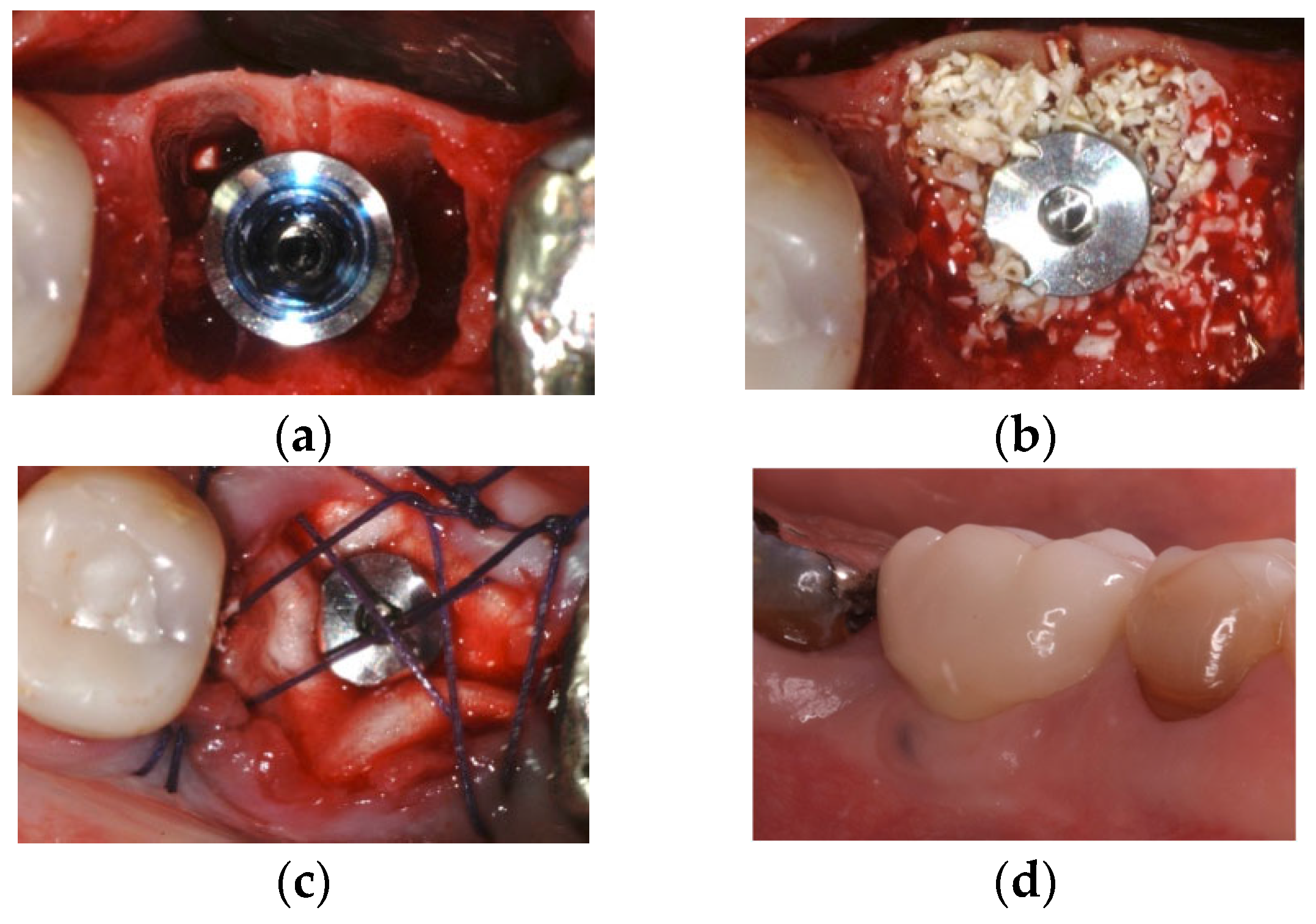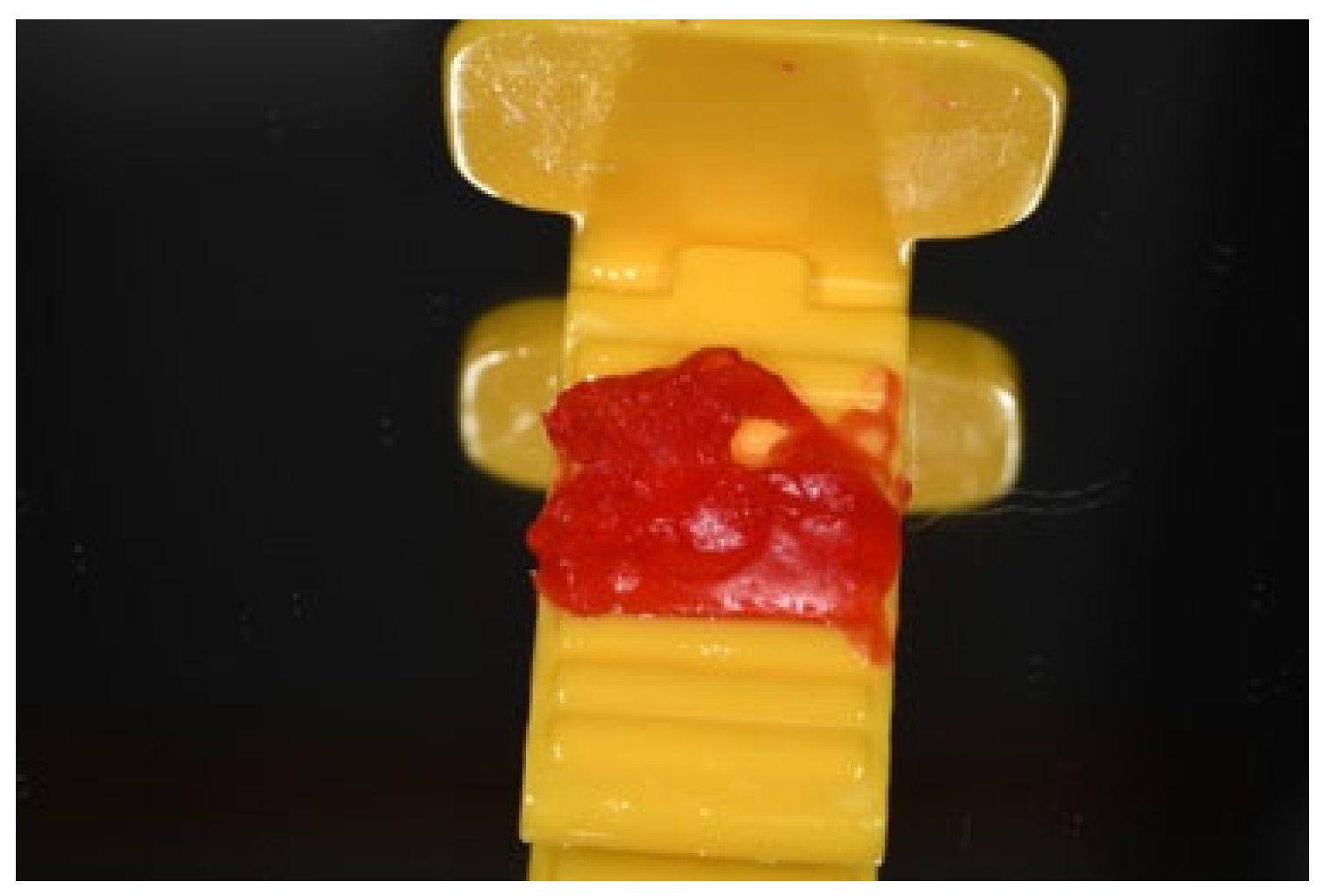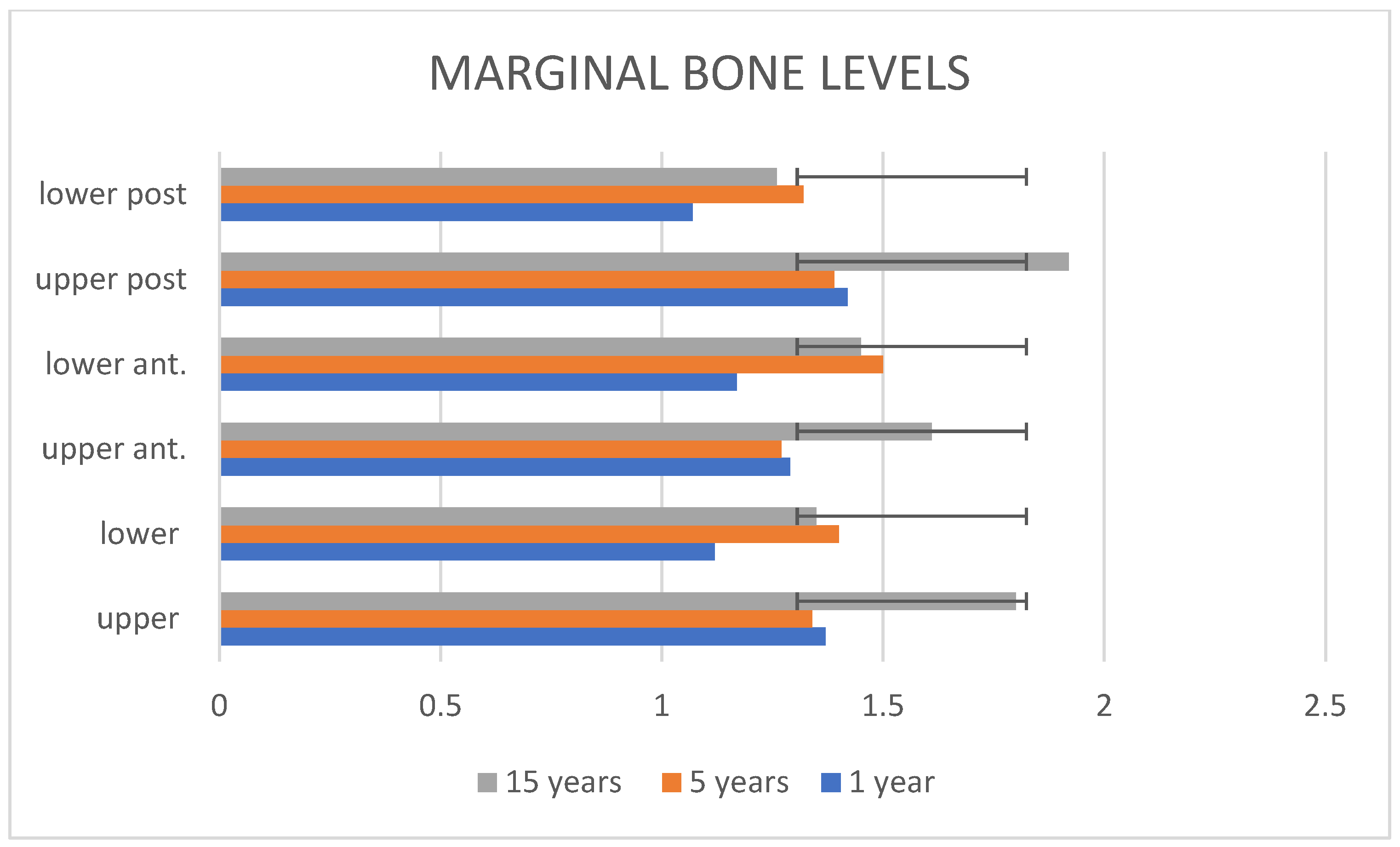Bone Stability After Immediate Implants and Alveolar Ridge Preservation: A 15-Year Retrospective Clinical Study
Abstract
1. Introduction
2. Materials and Methods
2.1. Sample Size Calculation
- n: dimension of the group.
- Z α/2: normal quantile for the chosen significance level (5%).
- Z β: normal quantile for the desired power (80%).
- σ2: variance of the variable (marginal bone level) (0.2).
- M1 − M2: minimum significant difference between the means of the two groups.
2.2. Methods
- Smokers (regardless of the number of cigarettes/day);
- Chronic periodontitis individuals;
- Poor oral hygiene or non-compliance with care;
- Presence of systemic conditions, compromised medical states, or immunosuppressive conditions contraindicating elective surgery or affecting recovery (i.e., non-compensated diabetes);
- Use of anticoagulant medications or bisphosphonates;
- Pregnancy or lactation;
- Acute apical infections at the tooth planned for extraction.
- Amoxicillin + Clavulanic Acid 875 + 125 mg, 2 g 1 h before surgery, or (in patients allergic to penicillin) Azithromycin 500 mg at the same timing
- Post-operative continuation with Amoxicillin + Clavulanic Acid 1 g 6 h after surgery or (in patients allergic to penicillin) Azithromycin 500 mg for 2 additional days
2.3. Statistical Analysis
3. Results
4. Discussion
5. Conclusions
Author Contributions
Funding
Institutional Review Board Statement
Informed Consent Statement
Data Availability Statement
Conflicts of Interest
References
- Faria-Almeida, R.; Astramskaite-Januseviciene, I.; Puisys, A.; Correia, F. Extraction Socket Preservation with or without Membranes, Soft Tissue Influence on Post Extraction Alveolar Ridge Preservation: A Systematic Review. J. Oral Maxillofac. Res. 2019, 10, e5. [Google Scholar] [CrossRef] [PubMed]
- Bontá, H.; Galli, F.G.; Gualtieri, A.; Renou, S.; Caride, F. The Effect of an Alloplastic Bone Substitute and Enamel Matrix Derivative on the Preservation of Single Anterior Extraction Sockets: A Histologic Study in Humans. Int. J. Periodontics Restor. Dent. 2022, 42, 361–368. [Google Scholar] [CrossRef] [PubMed]
- Seyssens, L.; Eeckhout, C.; Cosyn, J. Immediate Implant Placement with or without Socket Grafting: A Systematic Review and Meta-Analysis. Clin. Implant. Dent. Relat. Res. 2022, 24, 339–351. [Google Scholar] [CrossRef] [PubMed]
- Canellas, J.V.D.S.; Medeiros, P.J.D.; Figueredo, C.M.d.S.; Fischer, R.G.; Ritto, F.G. Which Is the Best Choice after Tooth Extraction, Immediate Implant Placement or Delayed Placement with Alveolar Ridge Preservation? A Systematic Review and Meta-Analysis. J. Craniomaxillofac. Surg. 2019, 47, 1793–1802. [Google Scholar] [CrossRef]
- Rignon-Bret, C.; Wulfman, C.; Valet, F.; Hadida, A.; Nguyen, T.-H.; Aidan, A.; Naveau, A. Radiographic Evaluation of a Bone Substitute Material in Alveolar Ridge Preservation for Maxillary Removable Immediate Dentures: A Randomized Controlled Trial. J. Prosthet. Dent. 2022, 128, 928–935. [Google Scholar] [CrossRef]
- Sapoznikov, L.; Haim, D.; Zavan, B.; Scortecci, G.; Humphrey, M.F. A Novel Porcine Dentin-Derived Bone Graft Material Provides Effective Site Stability for Implant Placement after Tooth Extraction: A Randomized Controlled Clinical Trial. Clin. Oral Investig. 2023, 27, 2899–2911. [Google Scholar] [CrossRef]
- Bharadwaz, A.; Jayasuriya, A.C. Recent Trends in the Application of Widely Used Natural and Synthetic Polymer Nanocomposites in Bone Tissue Regeneration. Mater. Sci. Eng. C Mater. Biol. Appl. 2020, 110, 110698. [Google Scholar] [CrossRef]
- Giannoudis, P.V.; Dinopoulos, H.; Tsiridis, E. Bone Substitutes: An Update. Injury 2005, 36, S20–S27. [Google Scholar] [CrossRef]
- Sohn, H.-S.; Oh, J.-K. Review of Bone Graft and Bone Substitutes with an Emphasis on Fracture Surgeries. Biomater. Res. 2019, 23, 9. [Google Scholar] [CrossRef]
- Lin, S.-C.; Li, X.; Liu, H.; Wu, F.; Yang, L.; Su, Y.; Li, J.; Duan, S.-Y. Clinical Applications of Concentrated Growth Factors Combined with Bone Substitutes for Alveolar Ridge Preservation in Maxillary Molar Area: A Randomized Controlled Trial. Int. J. Implant. Dent. 2021, 7, 115. [Google Scholar] [CrossRef]
- Di Girolamo, M.; Barlattani, A.J.; Grazzini, F.; Palattella, A.; Pirelli, P.; Pantaleone, V.; Baggi, L. Healing of the Post Extractive Socket: Technique for Conservation of Alveolar Crest by a Coronal Seal. J. Biol. Regul. Homeost. Agents 2019, 33, 125–135, DENTAL SUPPLEMENT. [Google Scholar] [PubMed]
- Pesce, P.; Mijiritsky, E.; Canullo, L.; Menini, M.; Caponio, V.C.A.; Grassi, A.; Gobbato, L.; Baldi, D. An Analysis of Different Techniques Used to Seal Post-Extractive Sites-A Preliminary Report. Dent. J. 2022, 10, 189. [Google Scholar] [CrossRef] [PubMed]
- Angelis, N.D.; Felice, P.; Pellegrino, G.; Camurati, A.; Gambino, P.; Angelis, N. De Guided Bone Regeneration with and without a Bone Substitute at Single Post-Extractive Implants: 1-Year Post-Loading Results from a Pragmatic Multicentre Randomised Controlled Trial. Eur. J. Oral Implantol. 2011, 4, 313–325. [Google Scholar] [PubMed]
- Moraschini, V.; Poubel, L.A.d.C.; Ferreira, V.F.; dos Sp Barboza, E. Evaluation of Survival and Success Rates of Dental Implants Reported in Longitudinal Studies with a Follow-up Period of at Least 10 Years: A Systematic Review. Int. J. Oral Maxillofac. Surg. 2015, 44, 377–388. [Google Scholar] [CrossRef]
- Albrektsson, T.; Zarb, G.; Worthington, P.; Eriksson, A.R. The Long-Term Efficacy of Currently Used Dental Implants: A Review and Proposed Criteria of Success. Int. J. Oral Maxillofac. Implant. 1986, 1, 11–25. [Google Scholar]
- Schwartz-Arad, D.; Laviv, A.; Levin, L. Failure Causes, Timing, and Cluster Behavior: An 8-Year Study of Dental Implants. Implant. Dent. 2008, 17, 200–207. [Google Scholar] [CrossRef]
- Solakoğlu, Ö.; Ofluoğlu, D.; Schwarzenbach, H.; Heydecke, G.; Reißmann, D.; Ergun, S.; Götz, W. A 3-Year Prospective Randomized Clinical Trial of Alveolar Bone Crest Response and Clinical Parameters through 1, 2, and 3 Years of Clinical Function of Implants Placed 4 Months after Alveolar Ridge Preservation Using Two Different Allogeneic Bone-Grafti. Int. J. Implant. Dent. 2022, 8, 5. [Google Scholar] [CrossRef]
- Menini, M.; Dellepiane, E.; Deiana, T.; Fulcheri, E.; Pera, P.; Pesce, P. Comparison of Bone-Level and Tissue-Level Implants: A Pilot Study with a Histologic Analysis and a 4-Year Follow-Up. Int. J. Periodontics Restor. Dent. 2022, 42, 535–543. [Google Scholar] [CrossRef]
- Bittner, N.; Planzos, L.; Volchonok, A.; Tarnow, D.; Schulze-Späte, U. Evaluation of Horizontal and Vertical Buccal Ridge Dimensional Changes After Immediate Implant Placement and Immediate Temporization with and Without Bone Augmentation Procedures: Short-Term, 1-Year Results. A Randomized Controlled Clinical Trial. Int. J. Periodontics Restor. Dent. 2020, 40, 83–93. [Google Scholar] [CrossRef]
- Fettouh, A.I.A.; Ghallab, N.A.; Ghaffar, K.A.; Mina, N.A.; Abdelmalak, M.S.; Abdelrahman, A.A.G.; Shemais, N.M. Bone Dimensional Changes after Flapless Immediate Implant Placement with and without Bone Grafting: Randomized Clinical Trial. Clin. Implant. Dent. Relat. Res. 2023, 25, 271–283. [Google Scholar] [CrossRef]
- Cardaropoli, D.; De Luca, N.; Tamagnone, L.; Leonardi, R. Bone and Soft Tissue Modifications in Immediate Implants Versus Delayed Implants Inserted Following Alveolar Ridge Preservation: A Randomized Controlled Clinical Trial. Part I: Esthetic Outcomes. Int. J. Periodontics Restor. Dent. 2022, 42, 195–202. [Google Scholar] [CrossRef]
- Schiegnitz, E.; Al-Nawas, B. Narrow-Diameter Implants: A Systematic Review and Meta-Analysis. Clin. Oral Implant. Res. 2018, 29 (Suppl. S1), 21–40. [Google Scholar] [CrossRef] [PubMed]
- Chen, S.T.; Buser, D. Esthetic Outcomes Following Immediate and Early Implant Placement in the Anterior Maxilla—A Systematic Review. Int. J. Oral Maxillofac. Implant. 2014, 29, 186–215. [Google Scholar] [CrossRef] [PubMed]
- Aghaloo, T.L.; Misch, C.; Lin, G.-H.; Iacono, V.J.; Wang, H.-L. Bone Augmentation of the Edentulous Maxilla for Implant Placement: A Systematic Review. Int. J. Oral Maxillofac. Implant. 2016, 31, s19–s30. [Google Scholar] [CrossRef]
- Marenzi, G.; Impero, F.; Scherillo, F.; Sammartino, J.C.; Squillace, A.; Spagnuolo, G. Effect of Different Surface Treatments on Titanium Dental Implant Micro-Morphology. Materials 2019, 12, 733. [Google Scholar] [CrossRef]
- Walter, P.; Pirc, M.; Ioannidis, A.; Hüsler, J.; Jung, R.E.; Hämmerle, C.H.F.; Thoma, D.S. Randomized Controlled Clinical Study Comparing Two Types of Two-Piece Dental Implants Supporting Fixed Restorations—Results at 8 Years of Loading. Clin. Oral Implant. Res. 2022, 33, 333–341. [Google Scholar] [CrossRef]
- Conserva, E.; Lanuti, A.; Menini, M. Cell behavior related to implant surfaces with different microstructure and chemical composition: An in vitro analysis. Int. J. Oral Maxillofac. Implant. 2010, 25, 1099–1107. [Google Scholar] [PubMed]
- Araújo, M.G.; Hürzeler, M.B.; Dias, D.R.; Matarazzo, F. Minimal Invasiveness in the Alveolar Ridge Preservation, with or without Concomitant Implant Placement. Periodontology 2000 2023, 91, 65–88. [Google Scholar] [CrossRef]
- Clementini, M.; Agostinelli, A.; Castelluzzo, W.; Cugnata, F.; Vignoletti, F.; De Sanctis, M. The Effect of Immediate Implant Placement on Alveolar Ridge Preservation Compared to Spontaneous Healing after Tooth Extraction: Radiographic Results of a Randomized Controlled Clinical Trial. J. Clin. Periodontol. 2019, 46, 776–786. [Google Scholar] [CrossRef]




| Total | |
|---|---|
| Males | 30 |
| Females | 20 |
| Age (total mean) | 50 |
| Age (women mean) | 49 |
| Age (men mean) | 51 |
| Implants in the upper jaw | 20 |
| Implant in the lower jaw | 30 |
| Biomet 3i | 30 |
| Straumann BL | 20 |
| Upper implants | 20 |
| Lower implants | 30 |
| Anterior implants | 21 |
| Posterior implants | 29 |
| 1 Year (mm) | p-Value (0.05) | 5 Years(mm) | p Value (0.05) | 15 Years (mm) | p-Value (0.05) | |
|---|---|---|---|---|---|---|
| Upper n = 20 | 1.37 ± 0.29 | 0.0015 | 1.34 ± 0.33 | 0.503 | 1.8 ± 0.38 | 0.0000685 |
| Lower n = 30 | 1.12 ± 0.19 | 1.4 ± 0.27 | 1.35 ± 0.27 | |||
| Upper ant. n = 8 | 1.29 ± 0.38 | 0.212 | 1.27 ± 0.45 | 0.213 | 1.61 ± 0.38 | 0.257 |
| Lower ant. n = 13 | 1.17 ± 0.16 | 1.5 ± 0.24 | 1.45 ± 0.3 | |||
| Upper post. n = 12 | 1.42 ± 0.22 | 0.0001 | 1.39 ± 0.24 | 0.39 | 1.92 ± 0.35 | 0.0001 |
| Lower post. n = 17 | 1.07 ± 0.2 | 1.32 ± 0.26 | 1.26 ± 0.22 |
Disclaimer/Publisher’s Note: The statements, opinions and data contained in all publications are solely those of the individual author(s) and contributor(s) and not of MDPI and/or the editor(s). MDPI and/or the editor(s) disclaim responsibility for any injury to people or property resulting from any ideas, methods, instructions or products referred to in the content. |
© 2025 by the authors. Licensee MDPI, Basel, Switzerland. This article is an open access article distributed under the terms and conditions of the Creative Commons Attribution (CC BY) license (https://creativecommons.org/licenses/by/4.0/).
Share and Cite
De Angelis, N.; Pesce, P.; Yumang, C.; Baldi, D.; Menini, M. Bone Stability After Immediate Implants and Alveolar Ridge Preservation: A 15-Year Retrospective Clinical Study. Dent. J. 2025, 13, 299. https://doi.org/10.3390/dj13070299
De Angelis N, Pesce P, Yumang C, Baldi D, Menini M. Bone Stability After Immediate Implants and Alveolar Ridge Preservation: A 15-Year Retrospective Clinical Study. Dentistry Journal. 2025; 13(7):299. https://doi.org/10.3390/dj13070299
Chicago/Turabian StyleDe Angelis, Nicola, Paolo Pesce, Catherine Yumang, Domenico Baldi, and Maria Menini. 2025. "Bone Stability After Immediate Implants and Alveolar Ridge Preservation: A 15-Year Retrospective Clinical Study" Dentistry Journal 13, no. 7: 299. https://doi.org/10.3390/dj13070299
APA StyleDe Angelis, N., Pesce, P., Yumang, C., Baldi, D., & Menini, M. (2025). Bone Stability After Immediate Implants and Alveolar Ridge Preservation: A 15-Year Retrospective Clinical Study. Dentistry Journal, 13(7), 299. https://doi.org/10.3390/dj13070299








